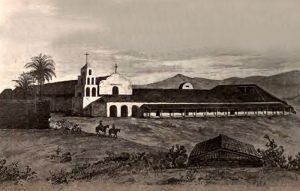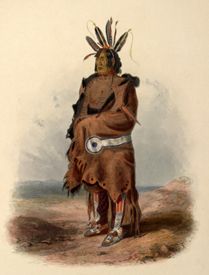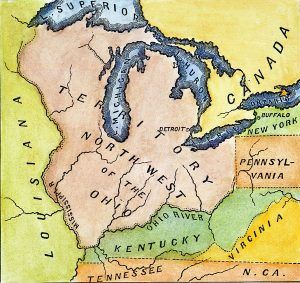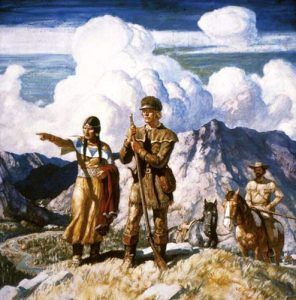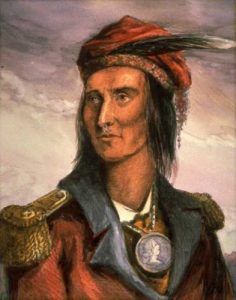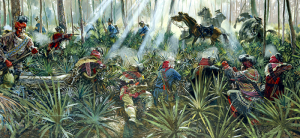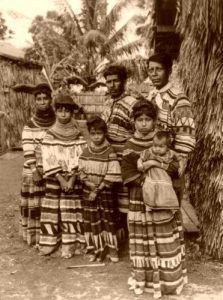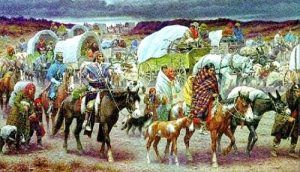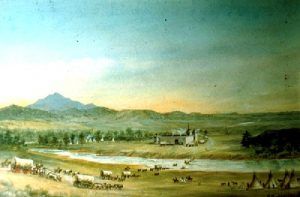When the American Revolution was over, the new United States had to deal with how to govern itself and deal with Native Americans as the nation pushed westward. During this time, many decisions were made that dealt with policies to keep the peace between white settlers and the Native Americans, as well as dealing with other issues such as the practice of slavery and social reforms.
1775-1850
1775 – Forced to labor in the mission fields and to worship according to the missionaries’ teachings, the Indians in San Diego, California, rebelled against the Spanish, burning every building and killing most of the inhabitants, including the mission’s head priest. Thanks to a Spanish sharpshooter, the Indians were finally driven off, and the Spanish retained control of their outpost.
1776 – On May 25, 1776, the Continental Congress resolved that it was “highly expedient to engage Indians in service of the United Colonies” and authorized recruiting 2,000 paid auxiliaries. The program failed, as virtually every tribe refused to fight for the colonists.
July 21, 1776 – Cherokee Indians attacked a settlement in western North Carolina. Militia forces retaliated by destroying a nearby Cherokee village.
1772-1780 – Eighty percent of the Arikara died of smallpox, measles, etc.
1776-1794 – Chickamauga Wars – A series of conflicts that continued the Cherokee struggle against white encroachment. Led by Dragging Canoe, who was called the Chickamauga by colonials, the Cherokee fought white settlers in Tennessee, Kentucky, Virginia, North Carolina, South Carolina, and Georgia.
1781 – Smallpox wiped out more than half the Piegan Blackfeet.
1782 – On March 8, 1782, Captain David Williamson and about 90 volunteer militiamen slaughtered 62 adults and 34 children of the neutral, pacifist, and Christian Delaware people at Gnadenhutten, Ohio, in retaliation for raids by other Indian tribes.
April 21, 1782 – The Presidio, overlooking San Francisco, was erected by the Spanish to subdue Indians interfering with mail transmissions along El Camino Real.
1785-1795 – Old Northwest War – Fighting occurred in Ohio and Indiana. Following two humiliating defeats at the hands of native warriors, the Americans won a decisive victory under “Mad Anthony” Wayne at the Battle of Fallen Timbers.
July 13, 1786 – The Northwest Ordinance was enacted, stating “the utmost good faith shall always be observed toward the Indians… in their property, rights, and liberty they shall never be disturbed.”
1787 – First federal treaty enacted with the Delaware Indians.
1789 – The Indian Commerce Clause of the Constitution is added, stating, “The Congress shall have Power… to regulate Commerce with foreign Nations, and among the several States, and with the Indian tribes.” This clause is the principal basis for the federal government’s broad power over Indians.
Indian agents, appointed as the federal government’s liaison with tribes, fell under the jurisdiction of the War Department. The Indian agents were empowered to negotiate treaties with the tribes.
1790 – The Indian Trade and Intercourse Act is passed, placing nearly all interaction between Indians and non-Indians under federal rather than state control, establishing the boundaries of Indian country, protecting Indian lands against non-Indian aggression, subjecting trading with Indians to federal regulation, and stipulated that injuries against Indians by non-Indians was a federal crime. The conduct of Indians among themselves while in Indian country was left entirely to the tribes.
A military battle occurred between the U.S. Army and Shawnee. The army, some 1,500 strong, invaded the Shawnee territory in what is now western Ohio. The Americans were defeated in 1791 after suffering 900 casualties, 600 of whom died.
March 1, 1790 – The first U.S. Census count included slaves and free African-Americans, but Indians were not included.
1792 – On November 6, George Washington expressed dissatisfaction in his fourth annual address to Congress that “Indian hostilities” had not stopped in the young country’s frontier, north of the Ohio River.
Pre-1795 – Trading begins between Native Americans and French and Spanish merchants from St. Louis, Missouri.
1795 – The Treaty of Greenville marked the end of an undeclared and multi-tribal war begun in the late 1770s and led by the Shawnee, who fought to resist American expansion into Ohio. In 1795, over a thousand Indian delegates ceded two-thirds of present-day Ohio, part of Indiana, and the sites where the modern cities of Detroit, Toledo, and Chicago are currently situated. The Indians, in return, were promised a permanent boundary between their lands and American territory.
1802 – Federal law prohibits the sale of liquor to Indians.
1803 – The Louisiana Purchase added to the United States French territory from the Gulf of Mexico to the Northwest.
The Lewis and Clark expedition begins its exploration of the West.
1804 to 1806 – Lewis and Clark’s expedition with Sacagawea. Under the direction of President Thomas Jefferson, Lewis and Clark charted the western territory with the help of Sacagawea, a Shoshone Indian.
1804 – The Sioux meet the Lewis and Clark Expedition.
Trading posts began to be established in the west.
Fur trading has become an essential part of Oglala life.
Oglala and other Lakota tribes expand their region of influence and control to cover most of the regions known as North and South Dakota, westward to the Big Horn Mountains in Wyoming and south to the Platte River in Nebraska.
On March 26, 1804, the U.S. government gave the first official notice to Indians to move west of the Mississippi River.
1808 – The Osage, a Sioux, signed the Osage Treaty ceding their lands in what is now Missouri and Arkansas to the U. S.
1808 to 1812 – Tecumseh, Chief of the Shawnee, and his brother, known as The Prophet, founded Prophetstown to settle other Indian peoples who believed that signing treaties with the U.S. government would culminate in the loss of the Indian way of life. Tecumseh also organized a defensive confederacy of Indian tribes of the Northwestern frontier who shared the common goal of making the Ohio River the permanent boundary between the United States and Indian land.
1809 – On February 8, Russians who built a blockhouse on the Hoh River (Olympic Peninsula, Washington) were taken captive by Hoh Indians and were held as slaves for two years.
On February 8, 1809, Russians who built a blockhouse on the Hoh River (Olympic Peninsula, Washington) were taken captive by Hoh Indians and were held as slaves for two years.
1810 – The Treaty of Fort Wayne brought the Delaware, Potawatomi, Miami, and Eel River Miami nations together to cede three million acres of land along the Wabash River to the United States.
Nicholas Biddle of the Lewis and Clark expedition noted that among the Minitaree Indians, the effeminate boys were raised as females. Upon reaching puberty, the boys were then married to older men. The French called them Birdashes.
1811 – On August 31, Fort Okanogan was established at the confluence of the Columbia and Okanogan Rivers; Indians met the Astorians with pledges of friendship and gifts of beaver.
On November 7, 1811, Shawnee leader Tecumseh’s dream of a pan-Indian confederation was squashed when his brother Tenskwatawa led an attack against Indiana Territory militia forces in the Battle of Tippecanoe. Tenskwatawa was defeated.
1813 to 1814 – The Creek War was instigated by General Andrew Jackson, who sought to end Creek resistance to ceding their land to the U.S. government. The Creek Nation was defeated at the Treaty of Fort Jackson and lost 14 million acres or two-thirds of their tribal lands.
1815 – Blacks and Creek Indians captured Fort Blount, Florida, from Seminole and used it as a haven for escaped slaves and a base for attacks on slave owners. An American army detachment eventually recaptured the fort.
On July 27, 1815, the Seminole Wars began.
1817 – Congress passed the Indian Country Crimes Act, which provided for federal jurisdiction over crimes between non-Indians and Indians and maintained exclusive tribal jurisdiction of all Indian crimes.
1820 – By this year, more than 20,000 Indians lived in virtual slavery in the California missions.
1821 – South Carolina settlers and their Cherokee allies attack and defeat the Yamassee.
The U.S. government began moving the “Five Civilized Tribes” of southeast America (Cherokee, Creek, Seminole, Choctaw, and Chickasaw) to lands west of the Mississippi River.
1823 – Johnson v. McIntosh Supreme Court decision – This case involved the validity of land sold by tribal chiefs to private persons in 1773 and 1775. The Court held that Indian tribes had no power to grant lands to anyone other than the federal government.
1824 – The Indian Office federal agency was established by the Secretary of War and operated under the administration of the War Department. The Office became the Bureau of Indian Affairs (BIA) in 1849.
1825 – Creek Chief William McIntosh signs a treaty ceding Creek lands to the U.S. and agrees to vacate by 1826; other Creek repudiates the treaty and kills him.
1827 – Creek Indians sign a second treaty ceding lands in western Georgia.
1828 – Elias Boudinot and Sequoyah began publishing the Cherokee Phoenix, the first American newspaper published in the Native American language.
1829 – Creek Indians receive orders to relocate across the Mississippi River.
1830 – On April 7, President Andrew Jackson submitted a bill to Congress to remove tribes in the east to lands west of the Mississippi. On May 28, the Indian Removal Act was passed, and from 1830 to 1840, thousands of Native Americans were forcibly removed.
On September 15, 1830, the Choctaw signed a treaty exchanging 8 million acres of land east of the Mississippi for land in Oklahoma.
On December 22, 1830, the State of Georgia made it unlawful for Cherokee to meet in council unless it was to give land to whites.
1831 – Black Hawk of the Sac and Fox tribes agrees to move west of the Mississippi River.
Cherokee Nation v. Georgia – The Cherokee Nation sued the State of Georgia for passing laws and enacting policies that limited their sovereignty and were forbidden in the Constitution. The Court’s decision proclaimed that Indians were neither U.S. citizens nor independent nations but rather were “domestic dependent nations.”
On December 25, 1831, Black Seminole Indians defeated U.S. troops at Okeechobee during the Second Seminole War.
1832 – On August 2, 1832, some 150 Sac and Fox men, women, and children, under a flag of truce, were massacred at Bad Axe River by the Illinois militia.
1833 – On January 12, a law was passed making it unlawful for any Indian to remain within the boundaries of the state of Florida.
1834 – The Indian Intercourse Act was passed. Congress created Indian Territory in the west, including the land in present-day Kansas, most of Oklahoma, and parts of what later became Nebraska, Colorado, and Wyoming.
1835 – Treaty of New Echota – A portion of the Cherokee nation agreed to give up Cherokee lands in the Southeast in exchange for land and removal to Indian Territory. A larger group of the Cherokee did not accept the terms of this treaty and refused to move westward.
1835-42 – The Second Seminole War was the most terrible of three wars between the U.S. government and the Seminole people and was also one of the most protracted and expensive wars in which the U.S. army was engaged.
1836 – In five groups, over 14,000 Creek Indians were forcibly removed by the U.S. Army from Alabama to Oklahoma.
1837 – Two-thirds of the 6,000 Blackfeet died of smallpox.
1838 – Trail of Tears – Despite the Supreme Court’s rulings in 1831 and 1832 that the Cherokee had a right to stay on their lands, President Jackson sent federal troops to forcibly remove almost 16,000 Cherokee who had refused to move westward. In May, American soldiers herded most into camps where they remained imprisoned throughout the summer, and at least 1,500 perished. The remainder began an 800-mile forced march to Oklahoma that fall. In all, some 4,000 Cherokee died during the removal process.
On January 30, 1838, Seminole leader Osceola died from complications of malaria at Fort Moultrie, South Carolina. He led a valiant fight against the removal of his people to Indian Territory, but eventually, the Seminole were forcibly relocated.
1841 – Forty-eight wagons arrive in Sacramento, California, by way of the Oregon Trail, one of the earliest large groups to make this journey.
1847 – Thomas H. Hardy, Superintendent of Indian Affairs in St. Louis, Missouri, warns of trouble from declining buffalo herds.
1849 – The U.S. Government purchases Fort Laramie, Wyoming, from the American Fur Company and begins to bring in troops.
The Bureau of Indian Affairs s transferred from the War Department to the newly-created Department of the Interior.
Physician services were extended to Indians with the establishment of a corps of civilian field employees.
January 24, 1849 – James Marshall discovers gold near Sutter’s Fort, California. News of the find begins the California Gold Rush of 1849, which displaces many Native Americans.
Compiled and edited by Kathy Weiser/Legends of America, updated January 2023.
Back – A New Nation, 1785-1876
Also See:
Native American Photo Galleries
Native Americans – First Owners of America


